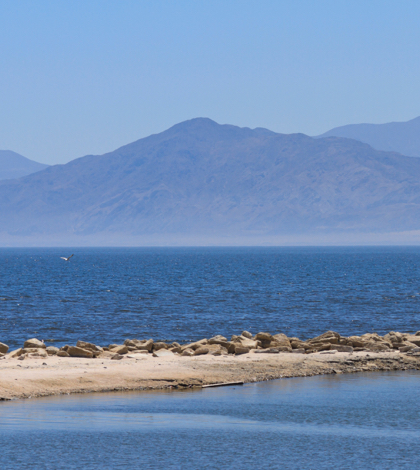Sen. Barbara Boxer (D-CA) has urged all levels of government agencies – state, federal and local – to step up their efforts to save the Salton Sea. Boxer spoke Thursday at the lakebed’s south shore Bono Salton Sea National Wildlife Refuge and expressed her concern for the slow action toward saving the 90,000 acres or 140 square miles of lakebed and the surrounding environment.
“The sea is drying up at an alarming rate, and we better deal with it. It is our job,” Boxer told officials after being briefed on restoration efforts at the lake. “If we do not act faster than we are acting now, we will face a public health disaster and an environmental disaster.”
Restoring the Salton Sea is a national wildlife priority as it serves as a vital stopover point along the Pacific Flyway for up to two-thirds of U.S. continental bird species. It is California’s largest lake but is facing eroding air quality, diminishing water supplies, and massive fish die-offs. The sea is at high risk of turning into a public health emergency; impacts are already being felt in the Imperial and Coachella Valleys, and as far away as Los Angeles.
The Salton Sea was created in 1905, by accident, when the Colorado River flooded and broke through existing Imperial Valley irrigation canals. However, the water that flows into the sea is disappearing and the situation is destined to get worse in the ensuing near-term. Whereas it has been sustained by agricultural runoff for nearly a century that runoff is declining because of a 2003 agreement which shifted some of the water to urban users. The situation will become more dire in 2017 when water deliveries to offset impacts of the 2003 agreement are scheduled to end. The continuing drought throughout the west and specifically in the Colorado River basin could potentially result in even less water flow to the sea.
Boxer’s comments delineated other issues besides the risks for migratory birds and the massive fish die-off. “We know already that children who live near the Salton Sea have the highest asthma hospitalization rates in the state,” Boxer said. “And then there is the strong odor of hydrogen sulfide being released by the dying sea from decaying fish, leaves and other organic matter, and the odor can extend all the way to Los Angeles – more than 100 miles away.
“On top of all of this, we have to deal with a warming climate which is expected to exacerbate these problems. As the temperature warms, the rate of evaporation from the sea will increase, accelerating the decline of sea levels which compounds the air quality problems,” she said.
It is estimated by the Pacific Institute, a global water think tank, that the continued failure to protect and preserve the Salton Sea could cost as much as $70 billion over the next 30 years due to worsening air quality and the loss of valuable ecological habitat along with diminished recreational revenue and property devaluation.
Efforts to rehabilitation the sea include a 2014 state water bond earmarked with $80.5 million for the Salton Sea. Boxer’s comments exhorted the state legislature to “step up and fill the promises made.”
Federally, the Obama administration has announced an additional $3 million for Salton Sea restoration. The funds will support the state’s long-term planning for the lakebed and will fund a 31-acre wetlands restoration project along the Alamo River to restore critical habitat and improve water quality.
Some restoration projects are already underway. At Red Hill Bay the U.S. Fish and Wildlife Service, the Imperial Irrigation District and the state are jointly working to restore 420 acres of wetlands to control dust and provide an environmentally safe habitat for fish and migratory birds. Because of these efforts Boxer contends that in 2007 she was able to include a provision allowing the U.S. Army Corps of Engineers to work with California on restoration of the Salton Sea.
But Boxer expressed her frustration in the slowdown of work on the Salton Sea because that 2007 plan was abandoned.
“I want to state very clearly that my provision was critical for getting the federal government to be a partner in this effort. Before 2007, there was no federal authorization to carry out restoration projects in the Salton Sea,” Boxer said. “Let me be clear: while the state will issue a new plan at the end of this year, my work was made much more difficult because the original 2007 plan was abandoned.”
Boxer’s comments pointed to the next steps in savings the Salton Sea – 1) a plan everyone agrees on; and 2) the commitment at every level of government – to marshal the resources necessary to make this plan a reality!
“I call on the California Natural Resources Agency, which leads the Salton Sea Management Program, to stick to its deadline of December 2016 to issue its long-range plan. This plan must be adopted without delay,” said Boxer.
While an implementation blueprint for the long-term plan is being completed, Boxer recommended that the involved parties should begin carrying out the short-term and medium-term goals for restoring the Salton Sea’s habitat and suppressing dust around the edges of the receding sea. She pointed to a list the state has already published of shovel-ready projects that can be started now.
In closing Boxer implored her colleagues saying, “There must be no backpedaling, because the dust won’t wait for us to act, the birds won’t wait for us to act and the children’s lungs won’t wait for us to act! We simply must do it!”
 California Water News Daily Your Source For Water News in California
California Water News Daily Your Source For Water News in California


